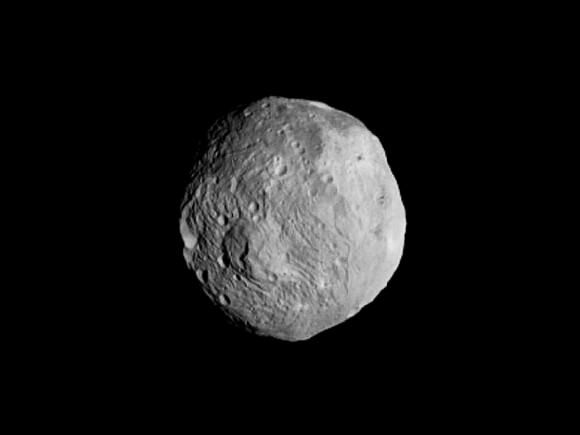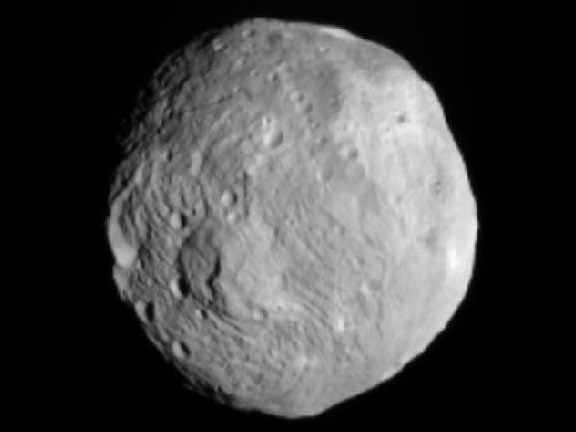[/caption]
As we anticipate the Dawn spacecraft going into orbit of Vesta within the next 36 hours, here’s the latest image taken as the spacecraft approaches Vesta, taken on July 9 from a distance of about 41,000 kilometers (26,000 miles). Surface details are coming into focus a little more than from the previous image that was released. The Dawn mission is exciting, as it will be the first spacecraft to enter orbit around a main-belt asteroid, and as we’ve said before, it will be intriguing for scientists to study this lumpy little world in detail and perhaps figuring out what Vesta really is.
Below is an “enhanced” look at this view of Vesta by Stu Atkinson.
Some astronomers classify Vesta as an asteroid, some a protoplanet, and some are on the fence. It’s not really considered a dwarf planet, but the classification could be re-evaluated when Dawn gets in orbit of Vesta and studies it in detail.

Stu sent us this image with the caveat that he created it for his own amusement/entertainment, and that it’s not a scientifically enhanced image — i.e., it’s not to be 100% relied upon for feature identification, etc. But it’s a little clearer and sharper than the original from NASA/JPL. Thanks Stu!
Engineers expect the spacecraft to be captured into orbit at approximately 10 p.m. PDT Friday, July 15 (1 a.m. EDT Saturday, July 16). They expect to hear from the spacecraft and confirm that it performed as planned during a scheduled communications pass that starts at approximately 11:30 p.m. PDT on Saturday, July 16 (2:30 a.m. EDT Sunday, July 17). When Vesta captures Dawn into its orbit, engineers estimate there will be approximately 9,900 miles (16,000 kilometers) between the spacecraft and Vesta. At that point, the two will be approximately 117 million miles (188 million kilometers) from Earth.
“It has taken nearly four years to get to this point,” said Robert Mase, Dawn project manager at NASA’s Jet Propulsion Laboratory in Pasadena, Calif. “Our latest tests and check-outs show that Dawn is right on target and performing normally.”
Engineers have been subtly shaping Dawn’s trajectory for years to match Vesta’s orbit around the sun with its ion engine. Unlike other missions, where dramatic propulsive burns put spacecraft into orbit around a planet, Dawn will ease up next to Vesta. Then the asteroid’s gravity will capture the spacecraft into orbit. However, until Dawn nears Vesta and makes accurate measurements, the asteroid’s mass and gravity will only be estimates. So the Dawn team will need a few days to refine the exact moment of orbit capture.
Launched in September 2007, Dawn will depart for its second destination, the dwarf planet Ceres, in July 2012. The spacecraft will be the first to orbit two bodies in our solar system.
Stay tuned for more details and updates on the Dawn mission.
Source: JPL


Wow.
Those three holes on the bottom left make it kind of look like a giant bowling ball. Cue the stories of giant intergalactic aliens returning to destroy Earth in 3.. 2..
Amazing. Can’t wait for tomorrow.
Hmm looks more like C3P0 from Star Wars…..cue the Death star theme ;O) Wonderful pics!!!!
Hmm looks more like C3P0 from Star Wars…..cue the Death star theme ;O) Wonderful pics!!!!
looks much more rounder that pics have lead us to believe most pics from the past look like a swooshed potato with a werid raised lump on it’s bottom side. these look beautiful…and yea i go with dwarf planet.
“The spacecraft will be the first to orbit two bodies in our solar system.” – it’s actually not so true as apollo missions orbited two bodies 🙂
I’ve seen speculation elsewhere that the view here may be looking down upon the huge, low profile crater seen by Hubble in the southern hemisphere of Vesta, with the broad central peak of the “crater” to the lower left of center.
Here’s a slightly different view of this area: http://www.nasa.gov/mission_pages/dawn/multimedia/dawn-image-070111.html
So it should be in orbit now, but we have nada in the way of news from the Dawn Mission, and just a paltry two images. Is that all they got for us? Talk about PR fail. Well the absence of news leads ‘me’ free to speculate.
1: Missed orbit; hard on the brakes atm..
2 Run into Vesta. Oops.
3: Found alien spiral base. 🙂 Nasa In news blackout while conferring with the Pentagon.
I hope its #3. !!
Which leads me to also say that in observing the last image the speculated upon south pole crater does not look much like one. (assuming that is the southern pole we are seeing in this image) BTW, thanks Dawn mission people for actually telling us what we are looking at; PR Fail x2
My initial thought on seeing it was that the bottom half of Vesta might have ‘cracked apart’ or perhaps had been “ground off”. Either way the Spiral grooves are way groovy. 🙂
Cant wait until they release another image, perhaps next month?
/ Sarcasm mode OFF
NASA won’t know for sure that Dawn is in the proper orbit until the probe’s antennas are realigned with Earth on Sun. 2:30 AM (I think EDT)